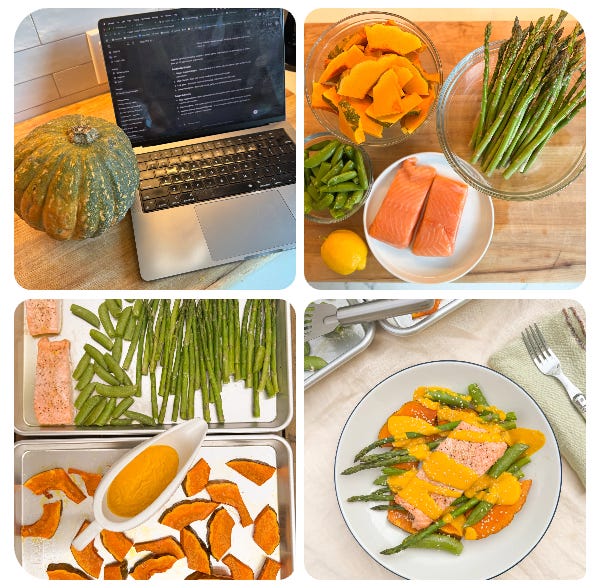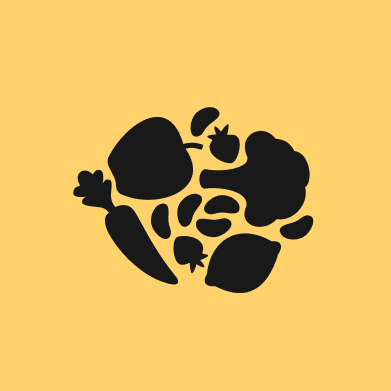As part of the Human AIgency series, I’m exploring practical ways to leverage AI to become more agentic in our everyday lives. For this piece, I’m collaborating with my friend, Sonja Manning, to spotlight how AI can support us in being more creative and experimental in the kitchen.
Sonja runs a Substack called Cooking in Color and a virtual cookbook community called Color Club where she shares simple and delicious recipes and home cooking tips every week. Her intention is to educate us on the powerful effects (and the accessibility) of a colorful whole food diet.
We first met at Levels, the health tech startup on a mission to help people understand how their diet and lifestyle choices are impacting their metabolic health. We bonded over our shared obsessions for metabolically healthy food swaps, the perfect Notion setup, and the great outdoors.
I consider myself to be relatively novice in the kitchen. I’m a throw-everything-into-the-pan-and-make-a-stir-fry type of chef while Sonja is a home chef who creates new recipes on the weekly.
We chat about the fun ways we’ve used AI as our sous chef to level up our kitchen game.
AI in the kitchen
Cissy: I’m bullish on AI’s ability to help humans become more agentic, particularly when it comes to trying things we might typically shy away from.
In this case, I’ve historically spent very little time in the kitchen, partly because I’ve lacked the confidence to experiment. I’m perfectly content eating the same handful of meals on rotation so for most of my adult life, I’ve stuck to a few variations of the same recipes.
Using AI in the kitchen has allowed me to become far more experimental with mixing random ingredients together and more confident that whatever I’m cooking up will actually be edible. I’m cultivating a deeper intuition for cooking and feel more creatively empowered simply because I’m cooking more often.
As someone who loves cooking, what’s your stance on AI’s role in the kitchen?
Sonja: In the kitchen, I’ve basically replaced Google with ChatGPT for anything I’m wondering, want to learn more about, or want help brainstorming. I’ve become a better home chef by learning tips and techniques for things like quickly caramelizing onions (yes, it’s possible — see here!), braising, marinating, and more!
The thing I like about AI and cooking is that while it can help give ideas and techniques, AI can never fully replace the art of home cooking. It can help you determine what to make with what you’ve got in your fridge, what to do with random ingredients you have on hand, how to meal prep something new within the parameters of how you like to eat and cook, how to get the most flavor out of ingredients, or how to salvage a recipe gone wrong — but it’s still up to you to taste test and determine if you need more salt or spices and use your senses to modify dishes so they surprise and delight your taste buds. The best thing AI can do is help you (and home chefs everywhere!) develop a better intuition for how to combine ingredients and prepare meals in a way that helps you fall in love with cooking flavorful, nourishing meals at home.
The way I think about food is that it’s what helps us be and feel alive. Food meets our cellular needs, nourishes our bodies and minds, and supports our energy, health, and overall well-being. If ChatGPT can help me learn how to feel even more joy, pleasure from preparing and consuming naturally occurring unprocessed foods, then I’d say that’s a pretty excellent use case for AI!
ChatGPT: AI sous chef edition
Cissy: How do you leverage AI as part of your cooking process?
Sonja: I made a list and then ChatGPT helped me turn it into this epic table👇🏼🤣
The only thing ChatGPT can’t promise is that a recipe will taste good — that’s where a human absolutely must still be in the loop to test and modify. If I just whipped up recipes from ChatGPT and published them as is on my Substack or my Color Club, I’d have very few subscribers 🤣
Cissy: Two things I’ll add that have been particularly useful for my cooking process:
Salvaging a recipe (e.g., replacing an ingredient if I’m out of it or messed up some measurement of the recipe)
Taking a photo of what I have available and asking it to generate a good on-the-fly recipe that takes <X time
Cissy: Of all the ways you’ve used AI in the kitchen, do any stand out as favorites?
Sonja: I subscribe to an organic community sponsored agriculture (CSA) program near LA called Earth Matterz , which means every week I get a bunch of seasonal produce that I then have to figure out what to do with! I often turn to ChatGPT (see 2 min Loom below) to brainstorm what to do with it!
For example, this week, I got a Kabocha squash. It’s mid-March so I wanted something spring-y with it and I wanted it to be simple since I was going to make it during the week (think sheet pan or one pan meal). 👇🏼
Cissy: Where has AI fallen short as compared to a human recipe tester? What’s your process for modifying and improving recipes?
Sonja: AI has no palate (yet? 😱). It doesn’t know if a dressing has too much or not enough acid, or if it needs more fat to bring out the flavor. I’ve found when it comes to the right proportion of ingredients it’s often too conservative with salt, acid, and heat.
For example, for the squash miso sauce for this sheet pan dish — the first version ChatGPT gave me was SO boring and dull, it needed more lemon, more tahini, and a touch more sweetness. I experimented with 3 versions before I was happy with it.
Cissy: What’s a recipe you’re particularly proud of that you started by using AI?
Sonja: Here’s the Miso Kabocha Salmon with Asparagus and Snap Peas recipe I made this week with my ChatGPT sous chef!
I’ve got hundreds more recipes up on my Color Club, head here and use code MOREMYSELF for a free first month.
the future of AI in the kitchen
Cissy: What predictions do you have for how AI capabilities will evolve in the kitchen?
Sonja: While we’ve already seen robots in kitchens all around the country from Sweetgreen to White Castle, I predict we will see AI continue to show up when it comes to meal planning apps as well as even smart appliances (e.g., AI vision to check doneness and auto-adjust based on the recipe and real-time cooking feedback).
We’ll also probably see AI (if not happening already) being trained on massive datasets of cuisines and cultures to do flavor pairings and menu design. I can imagine AI helping usher in an even more personalized nutrition feedback loop: think eating a meal, automatically logging glucose, HRV, mood response, and refining future recommendations. It’s like Levels + a private chef!
However, I believe there is something so human and primal about cooking. I hope that AI never fully replaces the human experience of preparing food. When I prepare my own food, I feel a deeper connection to the food, the earth, and the natural world.
The only reason you are reading this sentence right now is because you eat food that fuels you and keeps you alive. Once you eat something, it literally becomes you and becomes part of your 37 trillion cells. One of my favorite quotes is by Wendell Berry.
Eaters, that is, must understand that eating takes place inescapably in the world, and that it is an inescapable and agricultural act, and that how we eat determines, to a considerable extend how the world is used. This is a simple way of describing a relationship that is inexpressibly complex.
— Wendell Berry, The Pleasures of Eating
No matter what happens with AI — positive or negative — we must always strive to not lose sight of the most important part: food is living fuel that connects us to the earth.
prompts for your AI sous chef
Cissy: What prompts would you recommend our readers try? I personally love:
I’m baking X and Y — what should I season them with and how long do I need to bake them to make them flavorful and crispy?
What’s a fun, cultural twist I could add to this dish (with Chinese flavor) while making it metabolically healthy?”
I’m craving something comforting and colorful — can you help me create a bowl or plate that balances both using what I have in my fridge? (Add a photo)
Sonja: Any time you have any sort of cooking or meal planning question that pops up in your head like “I wonder what I should make this week” or “I wonder how I could use these two ingredients” — think of ChatGPT as you sous chef brainstorm partner.
Here are prompts I’ve used many times and love:
I have X ,Y, Z and common pantry items — give me 5 ideas of dishes I could make in less than 30 minutes using whole food ingredients with about 30g of protein per serving
I want to make a sauce that goes with XYZ — give me 5 ideas
A recipe calls for X amounts of XYZ but I want to find a substitute, what can I substitute? What should I know about how the ingredients operate differently?
Here are my ingredients I want to use and what I want to make. Write me a recipe for how to do it. (Then I test, modify, tweak, etc)
What are tips to make AMAZING XYZ?
I want to make X meals with seasonal ingredients. It’s X season and I live in X place. I avoid refined sugars, refined grains and seed oils, and try to make all blood sugar balanced meals. I like the cooking style of chefs like Sonja Manning, Molly Baz, Caro Chambers, Justine Dorion [fill in the name of your favorite chefs!]. Give me ideas for X meals!
If you enjoyed the recipe included above and want to try some of Sonja’s other recipes, head here, and use code MOREMYSELF for a free first month. (Not sponsored — I just love the work Sonja’s doing with Color Club and have personally enjoyed a number of her recipes!)
If you’re interested in other ways to use AI intentionally, you may enjoy:
If you’re new to either of our work, welcome! You can follow us here:
What are your favorite ways to use AI in the kitchen? Let us know in the comments!











This is so helpful! I used ChatGPT to help me make a smoothie and learned the hard way that it does not have taste buds, as mentioned here. Good for so many other parts of the recipe building and tracking, and it’s nice to have some clear suggestions outlined here. Love a good chart!